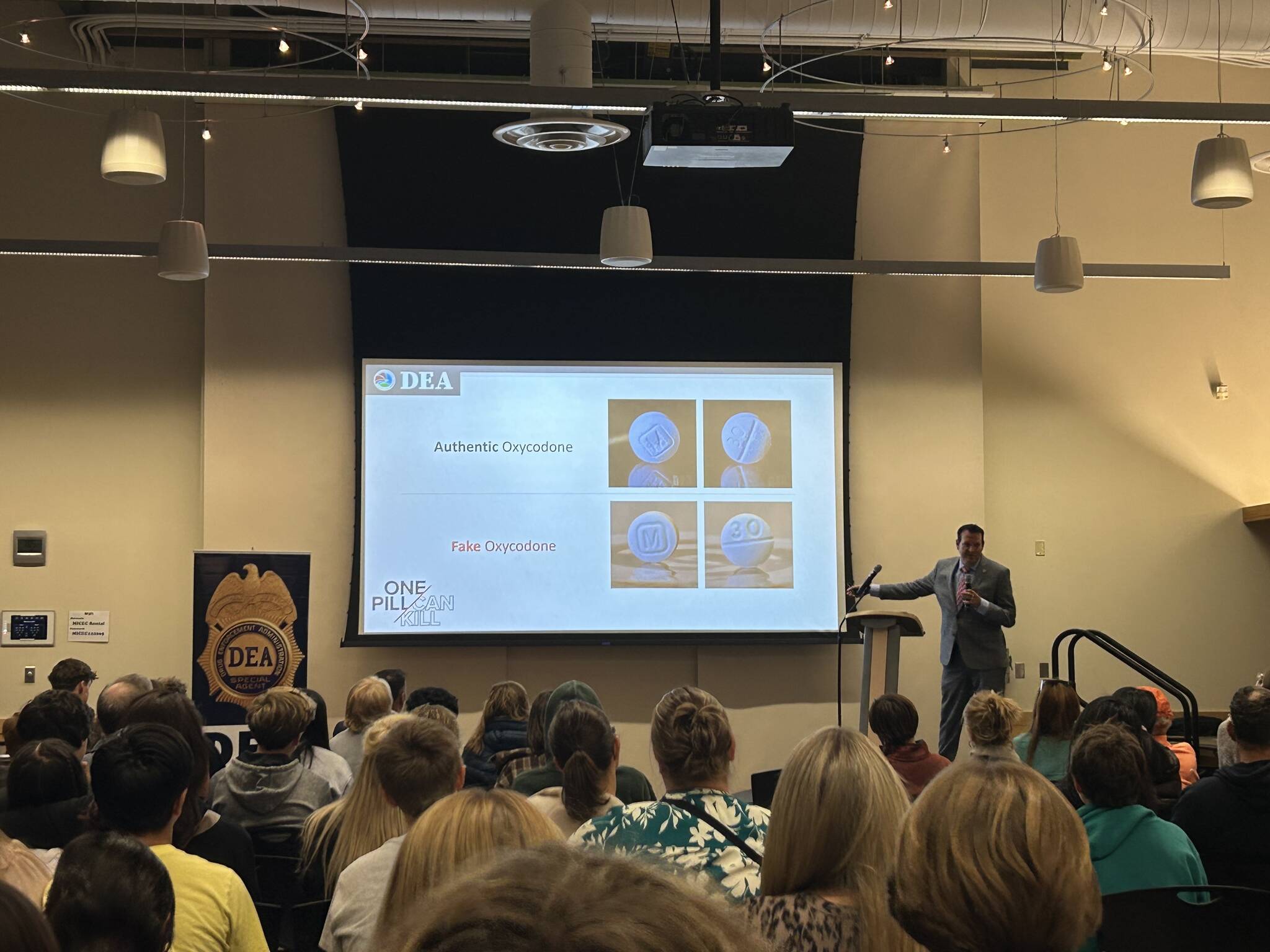A presentation called One Pill Can Kill was hosted by the Drug Enforcement Administration (DEA) and focused on fentanyl awareness.
The turnout of the Oct. 4 event at the Mercer Island Community and Event Center reflected the seriousness of the surge in opioid deaths within the United States and King County — and the devastation it leaves behind.
The deadly dose of fentanyl — a potent synthetic opioid drug— is 2 milligrams, said David Reames, the DEA special agent hosting the event. As of 2022, the DEA found 70% of the pills they tested contained 2 milligrams of fentanyl.
Reames said fentanyl is cheap, profitable and addictive, which is why it is the drug of choice to sell. However, the drug is not always sold upfront as fentanyl, but disguised as Oxycodone, Xanax, Adderall, or mixed in with a powder substance such as cocaine or heroin.
To the visible eye, it is impossible to distinguish which drug is real or fake. For this reason, the DEA and others call these cases drug poisonings instead of overdoses because many people believe they are getting a drug like Adderall, but it is fentanyl.
The latest data found in 2022 recorded over 109,000 drug deaths in the U.S., many from fentanyl, according to the Centers for Disease Control and Preve ntion.
The issue is local as well.
In 2020, King County recorded 168 fentanyl-involved deaths; in 2021, that number jumped to 385; by 2022, the death toll increased by 46% as the county saw 714 deaths; as of September 2023, the number has already reached 805 deaths this year, according to the King County Medical Examiner’s Office.
The rise of fentanyl
The average dose of fentanyl found in one pill has increased rapidly. As of 2018, one pill averaged 1.6 milligrams. In 2022, the average pill contained 2.4 milligrams, according to the DEA.
Reames gave an example of a heavy-set man who went to the hospital for a major injury and qualified for the largest dose of fentanyl medical personnel could give him — 200 micrograms.
In 1 milligram, there are 1,000 micrograms. The average pill in 2022 has 2,400 micrograms within it.
Though the deadly dose is 2 milligrams, Reams said just like any drug, people can build a tolerance, will need more to feel the effects, and can withstand more.
Unlike heroin made from a poppy plant or cocaine from a coca plant, fentanyl derives from a chemical compound. Reams said this makes it easier to produce all year, and it is harder to know how much is being produced.
However, the DEA does know that 3 million more pills have been seized compared to last year.
At the Oct. 4 presentation, someone from the crowd asked about testing drugs with a test kit. Reams said these drugs are like Tylenol — a small portion of the pill has the active ingredients, and the rest is filler. Therefore, testing drugs can be inaccurate, as one test can show negative traces of fentanyl, and another test with the same pill could be positive.
Another crowd member asked about naloxone — a nasal spray or injectable medicine to reverse opioid overdoses by attaching to opioid receptors, reversing and blocking the effects of other opioids.
Reams said while naloxone is effective, it only reverses an opioid overdose for 30 to 90 minutes, and after the time lapses, the effects of an overdose will continue. The strength of some opioids requires multiple doses of the medicine.
A personal anecdote
Laura Lynch is one of many victims who lost a family member to fentanyl poisoning.
In 2021, her daughter Brillion died at 18 years old, six days after her birthday.
Brillion went to take a nap and took what she thought was a Percocet to help her sleep. However, it was fentanyl, and the police said the dose in the fake Percocet was enough to kill 36 people.
Lynch said parents might think they can watch their child’s every move, but this is not the case. Brillion contacted the drug dealer through Instagram direct message and met at a Redmond skate park.
Lynch fought hard alongside police and detectives to track down the dealer. She said she was one of the lucky ones; the detective found the dealer, but she was dismayed when her case hardly held up in court.
“It was no small feat to get this into the court system. I did a lot of work and met with countless individuals trying to get attention to this,” she told the audience. “Prosecutors went from believing they could charge this person with homicide by controlled substances to not charging him with anything.”
The dealer ended up with a 20-month sentence, but was released in four and a half months.
“That is nothing for the life of my daughter,” Lynch said.
Nine months after the dealer was released, he was caught dealing drugs again.
“I encourage all of you to advocate and use your power as a voter. We all know Washington drug laws aren’t nearly adequate for the crisis we are facing now. I’ve been asked what I would have done differently as a parent, and there are so many things,” she said.
Speaking clearly and bluntly, Lynch said not to underestimate the immense damage low self-esteem can bring to a teen — the buildup of comparing oneself, bullying and trying to be the coolest or fit in. She said she would not have given her daughter a phone so early and would have monitored her laptop and phone.
“I just wanted her to feel happy and not feel left out; that will haunt me forever,” she said.


